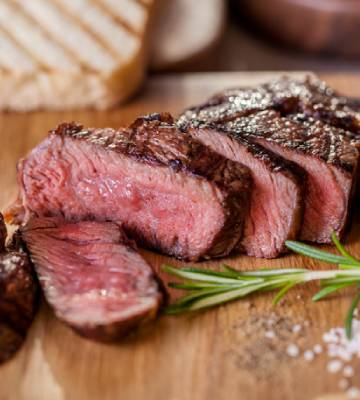Food Nutrition Facts
Nutrition Facts For
Steak (1/8 Fat Trim)
Portion Size: 3 Ounces
| Nutrient | Value | % Daily Value* |
|---|---|---|
| 130.0 kcal | 7% | |
| 14.0 g | 2% | |
| 6.0 g | 0% | |
| 80.0 mg | 27% | |
| 45 mg | 2% | |
| 280.0 mg | 9% | |
| 0.0 g | ||
| 0.0 g | ||
| 0.0 g | ||
| 0.0 g | ||
| 22.0 g | ||
| Beef |
*Daily value based on a 2,000 calorie diet. Your daily values may be higher or lower depending on your calorie needs and health goals.
Calculate your daily calorie needs here
Nutrition Facts For 3 Ounces of Steak (1/8 Fat Trim)

A typical steak will be between 4 ounces and 8 ounces.
Beef, the culinary name for meat from cattle (Bos taurus), is a significant global food source, prized for its rich flavor and nutritional value. It's a versatile protein, prepared and enjoyed in countless ways across diverse cultures. From succulent steaks and roasts to flavorful ground beef and hearty stews, beef offers a wide range of textures and tastes depending on the cut, preparation method, and animal's diet. Different cuts of beef come from various parts of the animal, each with unique characteristics influencing tenderness, fat content, and overall flavor profile. This diversity allows for a wide array of culinary applications, from quick weeknight meals to elaborate celebratory feasts. Beef provides essential nutrients, including protein, iron, and B vitamins, contributing to a balanced diet.
The quality and flavor of beef are influenced by several factors, including the breed of cattle, their feed, and how the meat is processed. Marbling, the intramuscular fat, contributes significantly to tenderness and flavor. Different grading systems, like those used in the United States, help consumers understand the quality of the beef they are purchasing. Whether it's a lean and flavorful tenderloin or a richly marbled ribeye, beef remains a popular and integral part of many cuisines worldwide.
Ounces to Pounds Conversion:
- 1 ounce (oz) = 0.0625 pounds (lbs)
- 1 pound (lb) = 16 ounces (oz)
To convert ounces to pounds, divide the number of ounces by 16. For example, 24 ounces is equal to 24 / 16 = 1.5 pounds. A typical size of steak is 4 ounces or 8 ounces.







